Issue#27
- Installing the GPPEs: Could they make it any harder?
- Another newsletter coming soon !
- Public GP Training Schedule Update
- Cities that are scheduled for public courses
- Subscribe, Unsubscribe, and Usage Information
Welcome to Newsletter #27.
As some of you know, the GPPEs, or Group Policy Preference Extensions are finally released.
They're here: they're real, and they're spectacular.
Apologies to Seinfeld fans everywhere.
But, even though theyre here, its going to take a little negotiating to make sure we dont install them, then, right away blow ourselves in the foot. This is a the first in a multi-part newsletter series.
First, we'll talk about installing the GPPEs. A little later, I'll have updates for automatically installing the GPPEs, then another newsletter on how to deal with the "overlaps" that are now created in the various categories.
Additionally inside this newsletter -- where I'm having public training courses and more.
PS: I know my graphics have the word "width" in them. Working on fixing that, but I wanted to get the newsletter out ASAP and fix it later.
Getting Down to Business: Installing the GPPEs
Microsoft likes to call them the Group Policy Preferences. But I like GPPEs, so Im going to keep calling them that.
The Group Policy Preference Extensions (GPPEs) look different than the rest of the Group Policy universe. Thats because they are different. They were born at Desktop Standard and integrated into Microsoft technology.
In all, it's a cool, cool brave new (or rather updated ) world. You can see the new Preferences node underneath User Configuration | Preferences and Computer Configuration | Preferences as seen here. 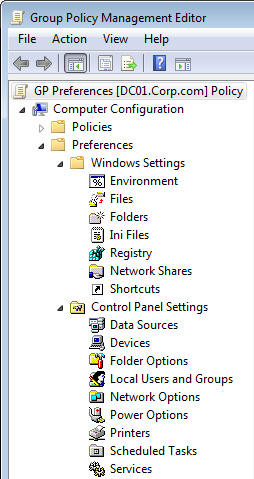
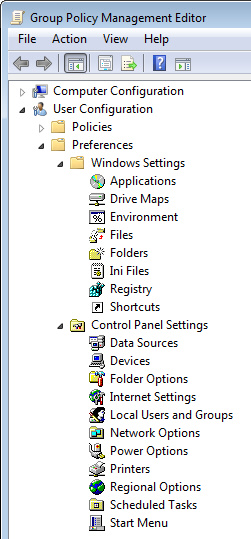 You might be asking yourself: why don't *I* see these in my GP editor? Because you're not using Windows Server 2008 as your editor or the download update (which isn't yet released) called RSAT which contains the updates.
You might be asking yourself: why don't *I* see these in my GP editor? Because you're not using Windows Server 2008 as your editor or the download update (which isn't yet released) called RSAT which contains the updates.
This is going to be a two-part newsletter. In this first part, we'll tackle installing the GPPEs. In the next part, we'll tackle one of the most misunderstood aspects of the technology. That s, why they are called Preferences in the first place and how they work differently than its Policy cousins.
Now that the GPPEs are available. How do you install them?
Well, it's different depending on the operating system. We'll explore that now.
The CSEs for Windows Server 2008
Everything you need to take advantage of the Group Policy Preference Extensions is already installed here. Both the management station pieces (where you define what you want to control) and the CSE piece (the .DLLs that process the GPOs).
So, if you wanted to get started using Group Policy Preference Extensions, you can do so immediately with very little effort by using a Windows Server 2008 machine.
The CSEs for Windows Server 2003, Windows XP, and Windows Vista
Again, for Windows Server 2003, Windows XP, and Windows Vista you need to download pieces to make the magic happen. Lets examine each operating system, where to get the downloads, and how to install the pieces by hand.
The Group Policy Preference Extensions can be downloaded from http://tinyurl.com/2za5zz. You can also track them down by heading over to http://www.microsoft.com/downloads and searching for the word "Preference."
Windows XP and Windows Server 2003 machines also need a prerequisite called XMLlite, and it can be found at http://support.microsoft.com/default.aspx/kb/914783 .
Here's the trick. Neither the XMLlite prerequisite nor the GPPEs themselves are MSIs.
Nope, they're patches.
So, for Windows XP and Windows Server 2003, they're .EXE patches, and for Windows Vista they're a newfangled format called .MSU for Microsoft Update patch.
And, if you'll recall, Group Policy Software Installation cannot install patches. You need a "big tool" like an SCCM 2007 or WSUS which expressly handles patch management. Or, you'll need a script to install it en-mass for your systems.
Ugh, what a nightmare!
You'll always be able to install each piece "by hand" (which we'll explore first), but you'll also want a mass-deployment recipe to start really rolling this out. I'll provide a script which helps you roll this out to your machines, so you're not running around from machine to machine doing all the dirty work. I don't have this ready yet, but along with my pal Jakob Heidelberg, I hope to have something for you in the next several days.
Installing the Prerequisites and CSEs for Windows Server 2003, Windows XP by hand
If youre installing the CSEs on Windows Server 2003, youll likely do each one by hand. This makes sense, as mass deploying and mass rebooting live servers can be, well, not good for your users. However, if you wanted to mass-rollout the CSEs, check out the section Installing the Prerequisites and CSEs for all operating systems automatically.
Again, both Windows XP and Windows Server 2003 have the prerequisite of XMLlite, a Microsoft middleware component. You can see the available command line switches in Figure X, if you want to do something fancy, or you can just double-click on the downloaded .EXE and kick off the installation. 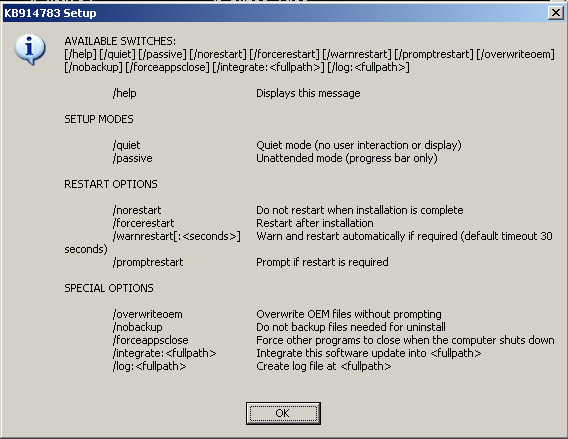 Figure: The XMLLite component's command-line switches
Figure: The XMLLite component's command-line switches
In my testing, the XMLlite components didn't require a reboot (but your mileage may vary.) Knowing this fact will come in handy when we try to automate the whole thing using a script. Next, in my testing, I simply double-clicked the .EXE which contained the CSE.
Once again, it didn't even require a reboot and it appeared ready to go. You might want to reboot once one the safe side for good measure.
You can verify the Group Policy Preference Extensions installed on Windows Server 2003 or Windows XP in Add or Remove Programs and clicking on "Show updates" as seen here. When you do, you'll see the hotfixes, like GPPE installation. 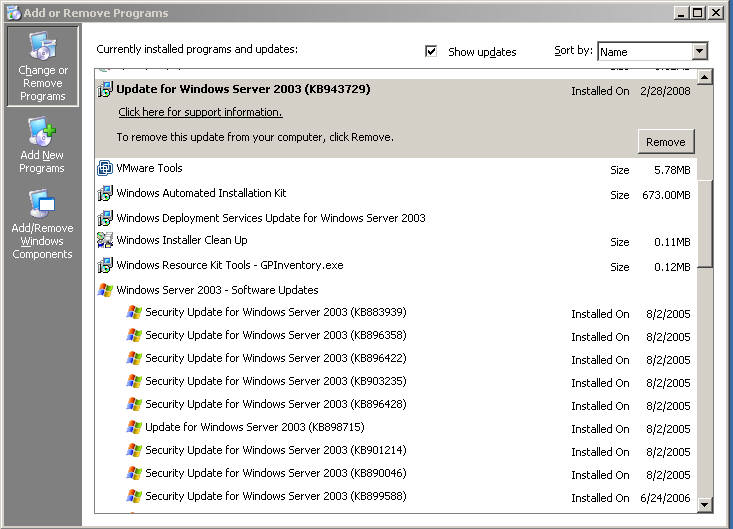 Figure: You can verify that the Group Policy Preference Extensions were installed on Windows XP and Windows Server 2003 by selecting Show updates.
Figure: You can verify that the Group Policy Preference Extensions were installed on Windows XP and Windows Server 2003 by selecting Show updates.
Installing the CSEs for Windows Vista by hand
The Windows Vista CSE ships as an MSU a Microsoft Update package as seen in Figure X. Just double-click on it and click OK to install, and youre off to the races. 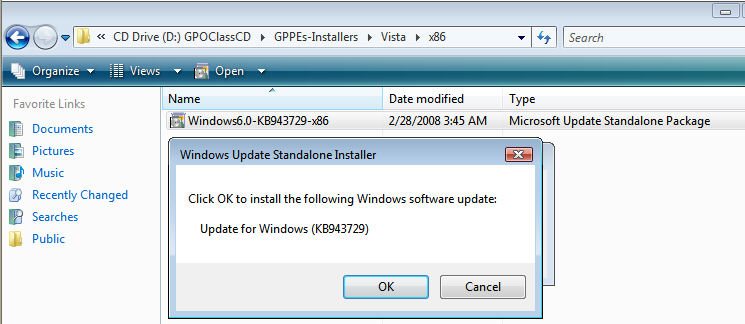 Figure: Installing the Windows Vista MSU file is like installing an executable
Figure: Installing the Windows Vista MSU file is like installing an executable
Again, in my testing there was no need to reboot after completion, but it certainly couldnt hurt. You can verify that the Group Policy Preference Extensions were properly installed by looking at Control Panel | Programs | Uninstall a program and then clicking Turn Windows features on or off as seen in Figure X.
Note the Group Policy Preference Extensions are on by default, and its not such a hot idea to turn them off. Note you can also see the MS KB update number as an installed update. 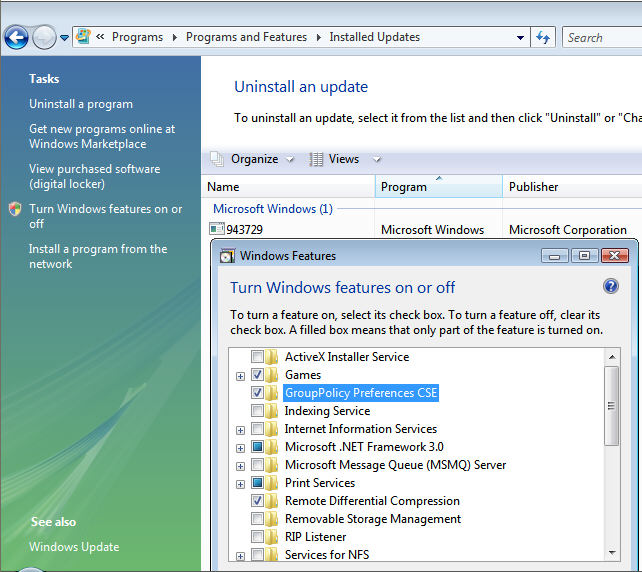 Figure: You can verify that the Group Policy Preference Extensions were properly installed
Figure: You can verify that the Group Policy Preference Extensions were properly installed
Installing the Prerequisites and CSEs for all operating systems automatically
Again, at this point, were still working on a fully-automating script to install the prerequisites and the GPPE CSEs.
Hang tight.
That'll appear in a tip or newsletter or something else soon.
Thing we're going to tackle #2 (in a newsletter coming soon): How Does the Group Policy Engine Deal with Overlaps?
This is something thats really, really confusing for a lot of people. And with good reason. There are lot of similar and shared areas in both Group Policy and the Group Policy Preference Extensions.
So to answer this question, there's the short answer, the middle-length answer and the long answer.
That'll be the next newsletter, which shouldn't be too far behind.
Hang tight, we'll explore this stuff at that point.
About GPanswers.com Training
I teach three courses on Group Policy now .. usually in the same week:
- Two Day Essentials Group Policy Training and Workshop
- Two Day "Group Policy 2.0" Training for Vista, Server 2008 and the Group Policy Preference Extensions and
- One-Day Advanced Group Policy Training
Learn more about each course here:
https://www.gpanswers.com/workshop/courses/
You can take the full week, or join us for just the classes you need.
Announced Classes:
- March 17 - 21: Portland, OR:
- This Class is ON. We have a really great group coming.
- It's the full week: Group Policy Essentials Course, Group Policy 2.0 Catch-up and Advanced One Day Course
- May 5 - 9: Kansas City, MO (Lenexa, KS, really)
- Class is ALMOST ON. If you sign up now, you'll be guaranteed a seat.
- It's the full week: Group Policy Essentials Course, Group Policy 2.0 Catch-up and Advanced One Day Course
- No other cities are announced yet. Maybe more coming soon, but I suggest if you want to get GP 2.0 training to come to one of these cities.
For any public class, sign up online at: https://www.gpanswers.com/workshop/
What about OTHER CITIES in 2008?
We have a new "Suggest a city" form at https://www.gpanswers.com/suggest .
Even if you've used this before, please re-suggest your cities, as we have a new back-end tracking system. Thanks !
Private courses
If you think you might want your own private in-house training (with all the personalized attention that affords), I'd love to join you onsite!
If you have even a handful of in-house people interested in the training (about 68), the course pays for itself (since you don't need to ship people offsite!). I'll even travel overseas to the U.K., other parts of Europe, Japanor wherever! Have passport, will travel!
Again, while the training course isn't officially endorsed by Microsoft, the class does have the distinction of being a suggested avenue for intense Group Policy training by members of the Group Policy, Microsoft Consulting Services, Security, and Product Support Services teams at Microsoft!
For a public class, sign up online at: https://www.gpanswers.com/workshop/ .
For a private class, just contact me at [email protected] or call me at 302-351-8408.
Don't forget our Sponsors
I can't tell you how often I hear that people LOVE the Solutions Guide we have at GPanswers.com/solutions. Inside, you'll find both free and third-party products which extend the reach of Group Policy, or let you do something you haven't discovered before!
So, head on over to the Solutions Guide and see what other goodies are available!
Be a GPanswers.com "Booster."
Do you feel you get value out of GPanswers.com and want to see us grow? Well, I'm a Group Policy guy, not a web guy, so I need to pay for my web services somehow and enhance the site and bring you more stuff.. (both features and content.)
If you'd like to help out, please consider making a one-time donation, or become a monthly GPanswers.com Booster for just $5 a month. If you and just 500 other people do it, I'll be able to pay for all the web bills each month and really take the site up a notch.
To help GPanswers.com and donate, here's how:
- Click here for a one-time donation (update quantity in cart)
- Click here to help with a $5 a month GPanswers.com Booster
Thank you for your support!
Subscribe, Unsubscribe, and Usage Information
If you've received this message as a forward from a friend, or are reading it online in the archives, you can sign up for your own newsletter subscription .
Also, if you want to unsubscribe, you can do that, too (but we'll be sad to see you go).
For all Subscription information, we have a one-stop-shop page at the following address: https://www.gpanswers.com/newsletter
You can use this information as you see fit, but if you're going to copy any portion, please FORWARD THE ENTIRE email.
While Moskowitz, inc. tries to ensure that all information is technically accurate, we make no warranty with regard to the information within. Please use at your own risk.
If you need personalized attention regarding subscriptions and unsubscriptions, just email me: [email protected]
Please POST your technical question on the GPanswers.com/community forum whenever possible.
If you have questions about ordering a book or signing up for a public class, contact my assistant Margot at: [email protected] . I endeavor to respond to everyone who emails.
Thanks for reading!




Comments (0)